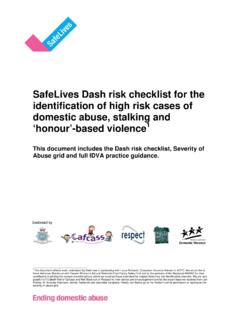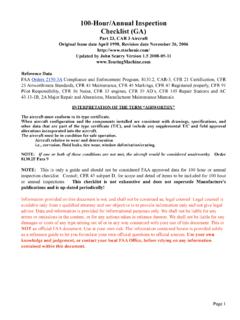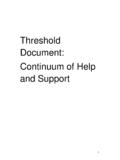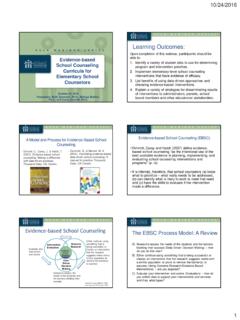Transcription of CAADA-DASH RISK IDENTIFICATION CHECKLIST FOR THE ...
1 CAADA-DASH RISK IDENTIFICATION CHECKLIST FOR THE. IDENTIFICATION OF RISK IN CASES OF DOMESTIC ABUSE, CAADA-DASH . STALKING RISK IDENTIFICATION . AND HONOUR'-BASED VIOLENCE CHECKLIST . Young for the people's version IDENTIFICATION of risk in cases of domestic abuse, stalking and honour'-based violence YOUNG PEOPLE'S VERSION with practice guidance In partnership Contents Introduction 3. The aim of the CHECKLIST and guidance 3. Using the Young People's CHECKLIST 4. Before you begin 4. Using the CHECKLIST 4. Notes on the use of language 6. CAADA-DASH Risk IDENTIFICATION CHECKLIST (RIC) Young People's Version 7. The aims of the CHECKLIST 7. Recommended referral criteria to MARAC 7. What the CHECKLIST is not 8. CAADA-DASH Risk IDENTIFICATION CHECKLIST Young People's Version 9.
2 Accompanying guidance to the Young People's CHECKLIST 14. Revealing the results to your client 27. This document is based on the original CAADA-DASH Risk IDENTIFICATION CHECKLIST , which was developed in partnership with Laura Richards, Consultant Violence Adviser to ACPO, and piloted with Advance, Blackburn with Darwen Women's Aid, Berkshire East Family Safety Unit and the Blackpool MARAC, with expert input from Cafcass, Respect, Jan Pickles, Dr Amanda Robinson, James Rowlands and Jasvinder Sanghera. We are grateful to the young people who helped us to develop this version of the tool and to Barnardo's, IKWRO and Leap: Confronting Conflict for convening the young people's advisory panels. caada 2013 please do not reproduce without permission W: T: 0117 317 8750 E: Registered charity number 1106864.
3 2. Introduction The CAADA-DASH Risk IDENTIFICATION CHECKLIST (RIC) for the IDENTIFICATION of risk in cases of domestic abuse, stalking and honour'-based violence in young people's relationships has been amended from the original version, designed for use with adults in 2009. This Young People's CHECKLIST will allow you to apply the wide ranging research available on risk in adult cases of domestic abuse, combined with the more limited evidence base that relates to young people experiencing intimate partner abuse, and use it to begin the risk assessment process with a young person who is being harmed within a relationship. This CHECKLIST forms part of the Young People's Programme and will be piloted during 2013 and 2014. alongside the collection of data through the work of Young Peoples Violence Advisors (YPVAs).
4 The form will be reviewed in April 2014. THE AIM OF THE CHECKLIST AND GUIDANCE. This Young People's CHECKLIST will help you to identify known risks in domestic abuse and include specific considerations in relation to young people to inform your professional judgment. It will help you to identify suitable cases to be reviewed at a MARAC and inform referrals to children's social care. caada 2013 please do not reproduce without permission W: T: 0117 317 8750 E: Registered charity number 1106864. 3. Using the Young People's CHECKLIST BEFORE YOU BEGIN. Introducing the CHECKLIST to your client Take time to familiarise yourself with the Young People's CHECKLIST before beginning work with your first client. This will help to ensure you feel confident about the relevance and implications of each question.
5 Whilst it is vital to work through the Young People's CHECKLIST quickly in order to gain an understanding of the client's situation, it is also important that a relationship with clear boundaries is created first where safety and trust is informed by active listening. The young people consulted during the development of the CHECKLIST were clear that they would respond best to the questions if they had an existing relationship with the person who was asking them. Explore the young person's understanding of what abuse is, helping them to define what the word means to them and identify how it relates to their own experience. Introduce the concept of risk to your client. Explain why you are asking these questions, what you will do with the answers, how it will help you as a professional and how it will help the young person.
6 You must also be clear as to who else might see this information. Avoid using jargon; opt for plain, simple language. Confidentiality and safeguarding It is important to explain your confidentiality and information sharing policies before beginning to ask the questions. You should be clear that, in most cases, the experience of relationship abuse by a young person will be a safeguarding issue and require a referral to the safeguarding children team. This will create transparency and clarity for the young person about how and when the information they disclose might be used and shared. Wherever possible, you should ask the young person to sign a form confirming that they understand and consent to these policies. Alternatively explain that, if they agree, you will sign on their behalf confirming they have understood and consented to the policy over the telephone.
7 Safety considerations Establish with the young person how much time they have to talk to you and whether it is safe for them to do so. Obtain the safe contact details of the young person in case the call is terminated, or they have to leave in an emergency. If you are completing the Young People's CHECKLIST on the phone or at the young person's home, check whether the person who hurts them is around, due back or expected back at a certain time. Be aware that a lesbian, gay, bisexual or transgender (LGBT) person accessing services will have to disclose both domestic abuse and their sexual orientation or gender identity. Creating a safe and accessible environment where a young person who has been harmed feels they make such a disclosure, and using gender neutral terms such as partner/ex-partner, is essential.
8 USING THE CHECKLIST . Ask all of the questions on the CHECKLIST . Ensure you have an awareness of the safety planning measures you can offer and put into place. It is also important to be familiar with local and national resources to refer your client to, including specialist services. Please note that the don't know' option is included where the young person who has been harmed does not know the answer to a specific question. It should be used when ticking no' would give a caada 2013 please do not reproduce without permission W: T: 0117 317 8750 E: Registered charity number 1106864. 4. misleadingly low risk level. This will also highlight to your agency, the child safeguarding team and the MARAC any areas which require more information to be gathered. Use the referral/care pathway to inform your practice.
9 You may also find it helpful to familiarise yourself with caada 's practice briefing for IDVAs on working with young people experiencing relationship When to use the CHECKLIST You should use the Young People's CHECKLIST with every young person who discloses to you that they are experiencing current abuse. The CHECKLIST offers an opportunity to identify the levels of risk a client may be exposed to, and to offer appropriate services. Current' abuse is where there has been any form of relationship abuse (including psychological, financial, sexual and physical abuse) occurring within the last three months. However this is not an absolute: risk can change and each young person's situation will differ. Therefore it is essential that professionals consider each case based on its own circumstances.
10 For this reason, in practice, the Young People's CHECKLIST will not easily apply to historic domestic abuse cases, ie if the abuse has ceased and the client is in need of general support not crisis services (NB current/recent abuse covers the spectrum of emotional/physical/financial/sexual and psychological abuse). However, if the client has only recently split from their partner, or recently rekindled a relationship that was abusive, the CHECKLIST will still be relevant. You should aim to complete the Young People's CHECKLIST on your first contact with the client. However, as has been highlighted, it may be best to first ensure an appropriate relationship is established between yourself and the young person to enable them to confide in you more readily. In such cases, be sure to complete the form at the earliest appropriate opportunity.






